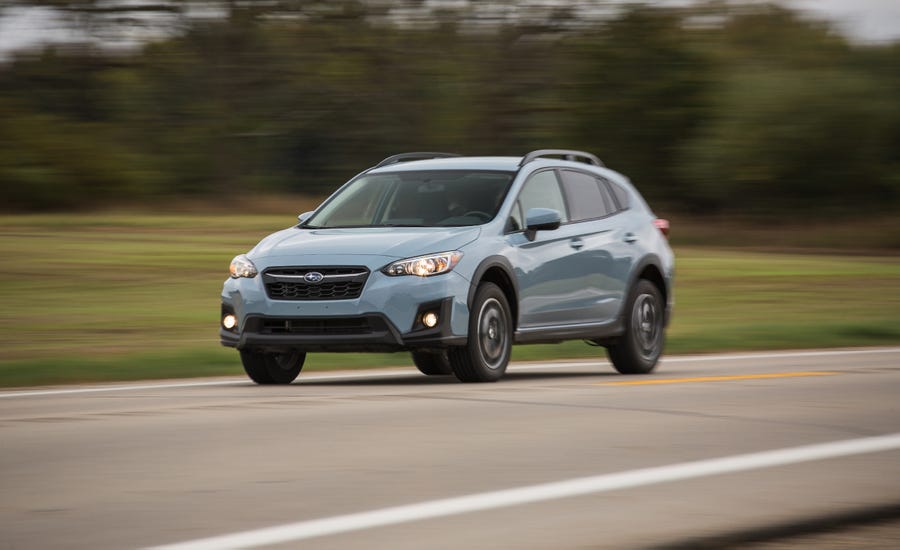
Shifting for yourself is so DIY!
The Crosstrek has been a sales hit for Subaru, coming in a solid third place after the larger Outback and Forester through October of this year. Although it’s just an Impreza lifted enough to boost it into the nebulously defined crossover category, the hatchback has carved out a segment for itself by dint of a low starting price and Subie’s ineffable greenie-cool factor. Add some charming and unexpected colors and a set of bold-looking wheels and you have a machine that accounts for 16 percent of the brand’s U.S. sales mix. Fundamentally, the Crosstrek has found a niche as the Chuck Taylor All-Star of cars: simple, cheap, cheerful, and welcome everywhere. Nobody is going to make fun of you for buying one.
Granola! Now with More Fiber!
For 2018, Subaru has moved the Crosstrek (and the Impreza) to its new Global Platform, and the results are immediately apparent. Although the 2018 model has gained only 93 pounds over the last stick-shift Crosstrek we tested, the car feels significantly more substantial. The doors close with a reassuring heft, rather than the cheapoid, tin-can feeling of the previous version.

Engine output has increased a bit, too, up 4 horsepower over the old car’s 148. But we managed just 17 seconds flat in the quarter-mile, which is a half-second slower than the old car. And the new Crosstrek also was 1.1 seconds slower from zero to 60 mph, needing 9.2 seconds to attain that mark.
One item the new Crosstrek doesn’t share with the Impreza is that car’s absolutely abysmal five-speed manual transmission (the old Crosstrek also used a five-speed manual). The Crosstrek’s six-speed is a peach, with none of the rubbery jankiness that makes the Impreza’s unit unpleasant. The shifter’s action is positive and smooth, while the clutch is communicative and linear in engagement.
And yet the Lineartronic continuously variable automatic, with its stepped “ratios,” seems to do a better job keeping the overworked 2.0-liter boxer four on the boil and yields almost identical results at the test track. It also gets better gas mileage: 29 mpg combined versus 25 for the stick-shift model, according to the EPA. Our 75-mph highway fuel-economy test also showed an advantage for the CVT: 32 mpg to the manual’s 31. But overall, in our testing, the manual returned 25 mpg to the CVT’s 23.

Which leaves us with a conundrum. Naturally, we encourage you to save the manuals, but the better overall car can trace its roots to Subaru’s tiny Justy, back through DAF’s zany Variomatic, and on to your French granddad’s old Mobylette. Yeah, we’re scratching our heads a bit, too.
Comfortable Frugality
The manual gearbox also is restricted to the Crosstrek’s two lower trim levels—2.0i and 2.0i Premium—since top-spec Limited models are CVT only. At $23,510 as tested, our Premium manual model features an interior that puts the previous Crosstrek’s to shame and finally feels segment appropriate (admittedly, not much of a task). The comfortable cloth seats are nicely stitched together with orange thread, which also is found on the leather shifter and the steering wheel to add a spot of playful fun. The Starlink infotainment system features a 6.5-inch touchscreen with Apple CarPlay and Android Auto functionality, and although it isn’t a standout in the world of in-car multimedia, it at least manages not to engender bouts of woeful frustration.
With this latest Crosstrek, Subaru has clearly opted to tune the chassis for comfort, and paired with the extra solidity of the structure, the decision pays dividends. The new machine offers excellent ride quality without sacrificing everyday handling. Push the small crossover to the max, however, and things come unstuck in the form of excessive understeer. We managed 0.81 g on the skidpad, which puts it ahead of the Jeep Renegade Trailhawk’s 0.72 g and the Nissan Rogue Sport’s 0.79 g; it’s on par with the Kia Soul Turbo but is 0.03 g behind our lower-riding Impreza hatchback long-termer.

Given that shoppers in the segment are more likely to be entranced by the thought of knocking over an REI than dodging cones on an autocross course, the cornering performance certainly is competent for the segment. What’s more, up to the limit, the Crosstrek feels perfectly content to zip down a country lane, soaking up imperfections without isolating the pilot from the business of driving. And even though the steering is low on feel, it’s at least accurate, and the chassis does its darnedest to hold the driver’s desired line.
Value, Utility, Zazz
Those concerned with maximum lifted-compact-wagon enjoyment might find themselves tempted by Volkswagen’s Golf Alltrack, but the manual-equipped German’s base price is almost $4000 north of the Subie’s. Put another way, for the price of an Alltrack, you could buy a Crosstrek and a really nice used dirtbike. Bonus? Among other colors, the Subaru can be ordered in a KTM-esque orange or a Yamaha-adjacent blue, for those who prize vehicular color coordination.
The new Crosstrek continues the previous car’s tradition of value, utility, and flannel-flyin’, millennial-baiting pizzazz, and its second iteration is better in just about every conceivable way (except for at the drag strip). And while we do think the CVT powertrain works a bit better than the manual in this application, by opting to shift your own gears you’ll save a thousand bucks and find yourself rewarded by a genuinely well-executed and pleasant gearbox. Pay your money and take your choice. It’s hard to lose either way.
Aucun commentaire:
Enregistrer un commentaire